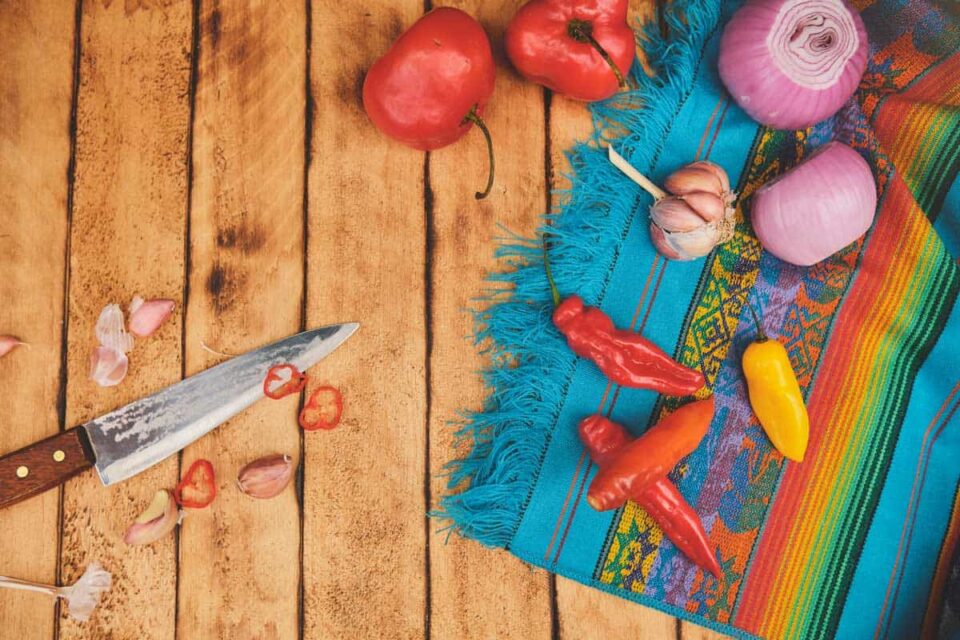Peruvian cuisine has long been celebrated for its diverse flavors, vibrant colors and rich cultural history. Being a melting pot of various influences, from indigenous Inca traditions to Spanish, African and Asian culinary styles, Peru’s food scene offers a unique and delicious experience for food enthusiasts. At the heart of this culinary treasure lies a wealth of traditional Peruvian ingredients.
This article will introduce you to some of the most important and unique ingredients of Peruvian cuisine, helping you understand their meaning and enhance your culinary journey.
So, buckle up and get ready to explore the fascinating world of Peruvian ingredients that every foodie should know about!
Basic Peruvian ingredients
Peruvian cuisine has many basic ingredients, especially vegetables.
Potatoes


With over 3,000 varieties, Peru is considered the birthplace of the potato.
This versatile tuber has been cultivated for thousands of years by ancient Andean civilizations and remains a staple in Peruvian cuisine today.
From the common white potato to colorful native varieties such as the purple “papa morada” and the yellow “papa amarilla”, each type boasts its own unique flavor and texture.
Potatoes are used in a variety of traditional Peruvian dishes, both as a main ingredient and as a side dish.
Some popular dishes include “causa” (a layered potato and seafood or chicken dish), “papas a la huancaina” (boiled potatoes with spicy huancaina sauce), and “carapulcra” (a stew made with dried potatoes and meat).
Quinoa


Quinoa, an ancient grain native to the Andean region, is highly prized for its rich nutritional profile.
Rich in protein, fiber and essential minerals, this gluten-free grain has become a popular Peruvian superfood around the world.
Quinoa is incredibly versatile and can be used in a wide range of Peruvian dishes, from soups and salads to more elaborate entrees.
Some favorites include “quinotto” (a quinoa-based risotto), “quinoa chaufa” (a Peruvian-Chinese fusion dish similar to fried rice), and “sopa de quinua” (a hearty quinoa soup).
To cook quinoa, simply rinse it thoroughly, then simmer it in water or broth until it becomes soft and tender.
Corn (Choclo)


Corn, or “choclo” in Quechuais another staple crop in Peru, boasting a wide range of unique and delicious varieties.
Peruvian corn is known for its large, chewy kernels and comes in a wide range of colors, such as white, yellow, and purple (maiz morado).
Corn is enjoyed in many forms, from freshly boiled “choclo con queso” (corn on the cob with cheese) to “humitas” (steamed corn dough filled with cheese or meat) and “chicha morada” (a refreshing purple corn drink ). .
It is commonly served alongside ceviche, Peru’s famous raw fish dish marinated in citrus juice and spices.
Unique Peruvian ingredients
Aji peppers


Aji peppers are an essential component of Peruvian cuisine, adding a burst of flavor and heat to a variety of dishes.
These versatile Peruvian chili peppers come in various forms, such as Aji Amarillo (yellow), Aji Panca (mild and smoky), and Aji Limo (spicy and fruity), each with its own distinct flavor and level of heat.
Aji peppers are used in a multitude of dishes, from sauces like “aji de gallina” (shredded chicken in creamy Aji Amarillo sauce) to ceviche and even in the preparation of traditional Peruvian soups and stews.
maca root


Maca root, a Peruvian cruciferous vegetable native to the Andean region, has been consumed for centuries for its various health benefits.
Often referred to as “Peruvian ginseng,” maca is believed to help increase energy levels, balance hormones and improve mental clarity.
Maca is generally found in powder form and can easily be added to smoothies, oatmeal, or baked goods.
It can also be used as a natural sweetener in place of sugar, offering a delicate caramel-like flavor.
Lucuma


Lucuma is a tropical fruit native to Peru with a unique taste often compared to maple syrup or sweet potato.
Rich in antioxidants, fiber and vitamins, lucuma is a healthy and delicious addition to any recipe.
Lucuma is widely used in famous Peruvian desserts, such as “helado de lucuma” (lucuma ice cream), “mousse de lucuma” (lucuma mousse), and “torta de lucuma” (lucuma cake).
The natural sweetness and creamy texture of the Peruvian fruit make it an ideal ingredient for creating delicious treats.
Traditional Peruvian herbs and spices
Huacatay (Peruvian black mint)


Huacatay, also known as Peruvian black mint, is an aromatic herb native to the Andean region.
With a unique flavor that is a blend of mint, basil, and tarragon, huacatay is a key ingredient in many traditional Peruvian dishes.
Huatay is often used in sauces, such as “salsa ocopa” (a creamy sauce made from huacatay, peanuts and Aji Amarillo) and “pachamanca” (a traditional Andean dish cooked underground with meat, potatoes and herbs).
It is also found in soups, stews and as a seasoning for grilled meats.
Paiko


Paico, a herbaceous plant native to the Andes, has been used for centuries by indigenous communities both for its medicinal properties and its unique flavor.
Known to aid digestion and relieve stomach discomfort, the Peruvian herb has a slightly bitter taste and is reminiscent of mint.
Paico can be used in a variety of dishes, from soups and stews to salads and sauces.
It is particularly appreciated in the preparation of “carapulcra” (a Peruvian potato and pork stew) and “anticuchos” (grilled meat skewers marinated in a tasty sauce).
Master Peruvian ingredients for a culinary adventure


In conclusion, the vibrant and seductive world of Peruvian cuisine is a treasure trove of flavors waiting to be discovered by food enthusiasts.
Familiarizing yourself with Peruvian ingredients will not only deepen your understanding of the rich cultural heritage behind these dishes, but will also allow you to recreate authentic Peruvian flavors in your own cooking.
May your food journey be filled with exciting discoveries and delicious Peruvian ingredients.
Happy cooking and bon appetite!


Our blog is all about sharing our love of Latin American foods and drinks. We will provide you with articles and recipes of the best Latin American and Spanish cuisine. Amygofoods was founded in 2003 and is the largest online grocery store offering a wide variety of freshly imported and hard-to-find foods and drinks from across Latin America and Spain.
More information about the author and Amigofoods on our Who we are page.
Please share and spread the love of Latin foods!

